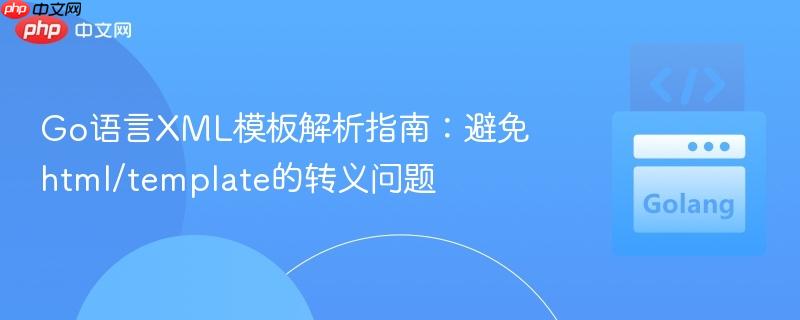
在go语言中处理xml模板时,直接使用`html/template`可能会导致xml声明中的特殊字符(如`
当开发者尝试使用Go语言标准库中的html/template包来解析和渲染XML文件时,可能会遇到一个常见的问题:XML声明(例如 <?xml version="1.0" encoding="utf-8"?>)中的尖括号<会被自动转义为HTML实体
例如,考虑以下一个简单的XML模板文件xml/in2.xml:
<?xml version="1.0" encoding="utf-8"?>
<in2>
<unique>{{.}}</unique>
<moe>100%</moe>
</in2>以及用于渲染此模板的Go代码片段:
package main
import (
"fmt"
"html/template" // 注意这里使用了 html/template
"net/http"
)
func in2Handler(w http.ResponseWriter, r *http.Request) {
w.Header().Set("Content-Type", "text/xml")
t, err := template.ParseFiles("xml/in2.xml") // 解析模板文件
if err != nil {
fmt.Println("Error parsing template:", err)
http.Error(w, "Internal Server Error", http.StatusInternalServerError)
return
}
uniqueData := "something" // 待填充的数据
err = t.Execute(w, uniqueData) // 执行模板并写入响应
if err != nil {
fmt.Println("Error executing template:", err)
http.Error(w, "Internal Server Error", http.StatusInternalServerError)
}
}
func main() {
http.HandleFunc("/in2", in2Handler)
fmt.Println("Server started on :8080")
http.ListenAndServe(":8080", nil)
}当上述代码运行时,访问/in2路径,输出的XML内容将变为:
立即学习“go语言免费学习笔记(深入)”;
<?xml version="1.0" encoding="utf-8"?>
<in2>
<unique>something</unique>
<moe>100%</moe>
</in2>可以看到,XML声明的开头<?xml被错误地转义成了
解决此问题的最直接和推荐的方法是使用Go语言标准库中的text/template包。与html/template不同,text/template是一个通用的文本模板引擎,它不会执行任何HTML实体转义,而是按原样输出模板中的内容。这使其成为处理XML、JSON、纯文本或其他非HTML格式模板的理想选择。
将上述Go代码中的html/template替换为text/template即可:
package main
import (
"fmt"
"net/http"
"text/template" // 替换为 text/template
)
func in2Handler(w http.ResponseWriter, r *http.Request) {
w.Header().Set("Content-Type", "text/xml")
t, err := template.ParseFiles("xml/in2.xml") // 使用 text/template 解析模板文件
if err != nil {
fmt.Println("Error parsing template:", err)
http.Error(w, "Internal Server Error", http.StatusInternalServerError)
return
}
uniqueData := "something"
err = t.Execute(w, uniqueData) // 执行模板并写入响应
if err != nil {
fmt.Println("Error executing template:", err)
http.Error(w, "Internal Server Error", http.StatusInternalServerError)
}
}
func main() {
http.HandleFunc("/in2", in2Handler)
fmt.Println("Server started on :8080")
http.ListenAndServe(":8080", nil)
}使用text/template后,再次运行代码并访问/in2,输出的XML内容将是正确的:
<?xml version="1.0" encoding="utf-8"?>
<in2>
<unique>something</unique>
<moe>100%</moe>
</in2>注意事项:
如果您的需求不仅仅是填充XML模板,而是需要更复杂地处理XML结构,例如解析现有XML、构建新的XML文档、进行XPath查询或对象-XML映射(序列化/反序列化),那么Go语言的encoding/xml包是更专业的选择。
encoding/xml包提供了将Go结构体编码为XML或从XML解码到Go结构体的功能。它允许您通过定义Go结构体来精确地控制XML元素的名称、属性和嵌套关系。
以下是一个使用encoding/xml构建并输出XML的简化示例:
package main
import (
"encoding/xml"
"fmt"
"net/http"
)
// 定义与XML结构对应的Go结构体
type In2 struct {
XMLName xml.Name `xml:"in2"` // 指定根元素名为in2
Unique string `xml:"unique"`
Moe string `xml:"moe"`
}
func in2XMLHandler(w http.ResponseWriter, r *http.Request) {
w.Header().Set("Content-Type", "text/xml")
// 创建一个In2实例并填充数据
data := In2{
Unique: "another_something",
Moe: "100%",
}
// MarshalIndent 将Go结构体编码为带缩进的XML
output, err := xml.MarshalIndent(data, "", " ")
if err != nil {
fmt.Println("Error marshalling XML:", err)
http.Error(w, "Internal Server Error", http.StatusInternalServerError)
return
}
// 添加XML声明头
w.Write([]byte(xml.Header)) // xml.Header 是 "<?xml version=\"1.0\" encoding=\"utf-8\"?>\n"
w.Write(output)
}
func main() {
http.HandleFunc("/in2-xml", in2XMLHandler)
fmt.Println("Server started on :8080")
http.ListenAndServe(":8080", nil)
}访问/in2-xml路径,将得到以下输出:
<?xml version="1.0" encoding="utf-8"?>
<in2>
<unique>another_something</unique>
<moe>100%</moe>
</in2>这种方法确保了XML的正确性和结构化,并且是处理复杂XML文档的推荐方式。
在Go语言中处理XML时,选择正确的工具至关重要:
通过理解这些工具的用途和限制,您可以根据具体需求选择最合适的Go语言包来高效、正确地处理XML数据。
以上就是Go语言XML模板解析指南:避免html/template的转义问题的详细内容,更多请关注php中文网其它相关文章!

每个人都需要一台速度更快、更稳定的 PC。随着时间的推移,垃圾文件、旧注册表数据和不必要的后台进程会占用资源并降低性能。幸运的是,许多工具可以让 Windows 保持平稳运行。

Copyright 2014-2025 https://www.php.cn/ All Rights Reserved | php.cn | 湘ICP备2023035733号